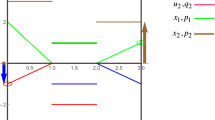Abstract
We consider the separated continuous linear programming problem with linear data. We characterize the form of its optimal solution, and present an algorithm which solves it in a finite number of steps, using an analog of the simplex method, in the space of bounded measurable functions.
Similar content being viewed by others
References
Anderson, E.J.: A Continuous Model for Job-Shop Scheduling. Ph. D. Thesis. University of Cambridge, Cambridge (1978)
Anderson, E.J.: A new continuous model for job-shop scheduling. Int. J. Syst. Sci. 12, 1469–1475 (1981)
Anderson, E.J., Nash, P.: Linear Programming in Infinite Dimensional Spaces. Wiley-Interscience, Chichester (1987)
Anderson, E.J., Philpott, A.B.: A continuous time network simplex algorithm. Networks 19, 395–425 (1989)
Anderson, E.J., Philpott, A.B.: Erratum, a continuous time network simplex algorithm. Networks 19, 823–827 (1989)
Anderson, E.J., Pullan, M.C.: Purification for separated continuous linear programs. Math. Methods Oper. Res. 43, 9–33 (1996)
Anstreicher, K.M.: Generation of feasible descent directions in continuous time linear programming. Technical Report, SOL 83–18, Department of Operations Research, Stanford University, Stanford (1983)
Barvinok, A.: A Course in Convexity American Mathematical Society, Providence (2002)
Bellman, R.: Bottleneck problems and dynamic programming. Proc. Natl. Acad. Sci. 39, 947–951 (1953)
Bellman, R.: Dynamic Programming. Princeton University Press, Princeton (1957)
Dantzig, G.B.: Linear Programming and Extensions. Princeton University Press, Princeton (1963)
Dorfman, R., Samuelson, P.A., Solow, R.M.: Linear Programming and Economic Analysis. MacGraw Hill, New York (Dover edn, 1987) (1958)
Fleischer, L., Sethuraman, J.: Efficient algorithms for separated continuous linear programs: the multicommodity flow problem with holding costs and extensions. Math. Oper. Res. 30, 916–938 (2005)
Fleischer, L., Skutella, M.: Quickest flows over time. SIAM J. Comput. 36, 1600–1630 (2007)
Fukuda, K., Terlaky, T.: Criss cross methods, a fresh view on pivot algorithms. Math. Program. 79, 369–395 (1997)
Grinold, R.C.: Symmetric duality for continuous linear programs. SIAM J. Appl. Math. 18, 32–51 (1970)
Hajek, B., Ogier, R.G.: Optimal dynamic routing in communications networks with continuous traffic. Networks 14, 457–487 (1984)
Ito, C., Kelley, T., Sachs, E.W.: Inexact primal dual interior point iteration for linear program in function spaces. Comput. Optim. Appl. 4, 189–202 (1995)
Koopmans, T.C. (ed.) in Cooperation with Alchien, A., Dantzig, G.B., Georgescu-Roegen, N., Samuelson, P.A., Tucker, A.W. Activity Analysis of Production and Allocation. Wiley/Chapman and Hall, New York/London (1951)
Leontief, W.W.: The Structure of the American Economy, 1919–1929 Harvard University Press, Cambridge (new, enlarged edition, Oxford University Press, New York, 1951) (1941)
Luo, X., Bertsimas, D.: A new algorithm for state constrained separated continuous linear programs. SIAM J. Control Optim. 37, 177–210 (1998)
Nazarathy, Y., Weiss, G.: Near optimal control of queueing networks over a finite time horizon Annals of Operations Research (to appear) (2007)
Perold, A.F.: Fundamentals of a continuous time simplex method. Technical Report, SOL 78-26, Department of Operations Research, Stanford University, Stanford (1978)
Perold, A.F.: Extreme points and basic feasible solutions in continuous time linear programming. SIAM J. Control Optim. 19, 52–63 (1981)
Philpott, A.B., Craddock, M.: An adaptive discretization algorithm for a class of continuous network programs. Networks 26, 1–11 (1995)
Pullan, M.C.: An algorithm for a class of continuous linear programs. SIAM J. Control Optim. 31, 1558–1577 (1993)
Pullan, M.C.: Forms of optimal solutions for separated continuous linear programs. SIAM J. Control Optim. 33, 1952–1977 (1995)
Pullan, M.C.: A duality theory for separated continuous linear programs. SIAM J. Control Optim. 34, 931–965 (1996)
Pullan, M.C.: Existence and duality theory for separated continuous linear programs. Math. Model. Syst. 3, 219–245 (1997)
Pullan, M.C.: Convergence of a general class of algorithms for separated continuous linear programs. SIAM J. Optim. 10, 722–731 (2000)
Pullan, M.C.: An extended algorithm for separated continuous linear programs. Math. Program. 93, 415–451 (2002)
Shapiro, A.: On duality theory of conic linear problems. In: Goberna, M.A., Lopez , M.A.(eds) Semi-Infinite Programming, Chap. 7., pp. 135–165. Kluwer, Netherlands (2001)
Vanderbei, R.J: Linear Programming, Foundations and Extensions. Kluwer, Boston, 2nd edn. 2001 (1997)
Weiss, G.: On optimal draining of fluid re-entrant lines. In: Kelly, F.P., Williams, R.(eds) Stochastic Networks, IMA Volumes in Mathematics and its Applications, pp. 93–105. Springer, New York (1995)
Weiss, G.: Scheduling and control of manufacturing systems—a fluid approach Proceedings of the 37 Allerton Conference, pp. 577–586, 21–24 September, 1999, Monticello (1999)
Author information
Authors and Affiliations
Corresponding author
Additional information
Research supported in part by US-Israel BSF grant 9400196, by German-Israel GIF grant I-564-246/06/97 and by Israel Science Foundation Grants 249/02 and 454/05.
Rights and permissions
About this article
Cite this article
Weiss, G. A simplex based algorithm to solve separated continuous linear programs. Math. Program. 115, 151–198 (2008). https://doi.org/10.1007/s10107-008-0217-x
Received:
Accepted:
Published:
Issue Date:
DOI: https://doi.org/10.1007/s10107-008-0217-x



